Joanna Seddon, Managing Partner, Presciant
Nikhil Gharekhan, Managing Partner, Presciant
Will things go up in 2023? Or go down? More likely, they will go round and round. What we know about branding no longer works. Old brand thinking is irrelevant. Those who follow it will not survive.
Looking ahead, trying to live up to our name—Presciant, we believe that brands face an imperative. Shed all preconceptions, ignore the past. Look around you. Observe, think and react. Do you agree? Are you doing this? We’d love to know.
Ten key trends:
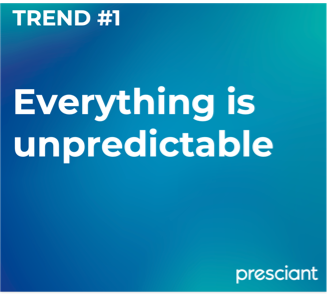
How should brands react? Never sit still. Challenge all received wisdom. Change constantly. But don’t change everything. Decide what is core to who you are, what your purpose and reason for existence is. Stick to it. Keep what makes your brand special secure. Treat the core as sacrosanct and everything else as fluid. Build on your heritage and differentiators. Don’t throw them out of the window. Be willing to transform on a dime, but in a way which is authentic to who you are. Expect the unpredictable. Be ready for it.
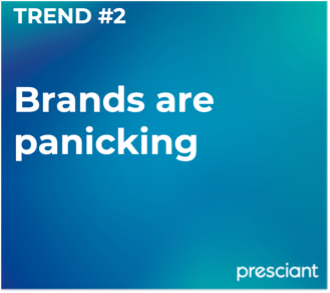
Some are running amok. Carving themselves up, sometimes for good reason, sometimes for no obvious reason. Kraft started it, with the creation of Mondelez. Unilever was next, spinning off first its margarine business in 2018, then its smaller beauty and personal care and tea businesses in 2021, with food likely to follow this year. This has ignited a perfect storm. GE is re-forming as Aerospace, Healthcare and Energy; GSK has IPO’d its consumer business; J&J is about to; Ernst & Young is trying to divorce its advisory and audit businesses; P&G, perhaps to its credit, has largely kept aloof.
These carve-outs own familiar and iconic brands, from Cadbury, to Lipton, to Johnson’s Baby, Band-Aid and Tylenol, to Corn Flakes and Rice Krispies, to Centrum and Tums. They now come under a new set of corporate names. These names are befuddling at first—Upland, Elida, Ekaterra, Haleon, Kenvue, Vernova, …. But there has been hard thinking behind their creation. There’s a new convention—take 2 relevant words with ancient roots, stick them together, and hope the idea comes through. Haleon is said to “combine the blessings of good health and strength, from hale and leon.” Ekaterra comes from eka, the Sanskrit for one, and the Latin terra for land. These new corporate brands are going to have a hard time to stand out from the flow. There’s just too many of them.
Other companies are trying to reinvent themselves but shying away from changing their name. This can be worse. After huge angst, GE is committing what is generally regarded as the cardinal brand sin of launching 3 companies under the same name. You can see why—the GE brand has huge equity in each of the 3 businesses, aerospace, healthcare, and energy. Perhaps it will work. But the experience of other companies shows that generally, this move destroys shareholder value. Just look at HP. Another tactic which has come into vogue is playing with your name to try and look modern. Tech has long cut the number of vowels down, to make the names easier to trademark—Flickr and Tumblr. But now there is a ridiculous trend for names with no vowels. Our favorite bad examples are ABRDN (Aberdeen Insurance) and BHLDN (a bridal range from Urban Outfitters).
In this turbulent environment, companies should respect the value that the corporate brand can add or subtract from their financial value. Don’t take it lightly, take care with it.
A carve-out must have a reason for being—a set of businesses fit together and have a common purpose. That’s a prerequisite for building a corporate brand that will work and create value.
It’s good to put the thinking behind the creation of new corporate names, but not enough. You must invest significantly and consistently for at least 3-5 years in building corporate brand equity.
For the value of a new entity to be recognized by investors, examine your corporate brand architecture. Determine how to link the product brands back to the corporate brand. Design it so that the product brands will add equity to the infant corporate brand, and the corporate brand will contribute a powerful purpose and values back to the portfolio.
Please don’t be silly about names. Cutting out all your vowels does not make you cool; it just causes confusion. Branding is about substance, not window-dressing.
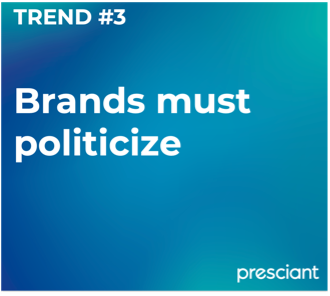
Why has this happened? The obvious answer is the polarization of society. You are an election-denying Republican or a pro-abortion democrat, a supporter of Bolsonaro or of Lulu. There is not betwixt and between. But that’s only part of it.
The onset of Purpose works as a multiplier. Having a Purpose plunges you into the political debate. Purpose is having a point of view about the world. Once you have a point of view, you must live up to it. Today, Purpose is about more than words. Our recent study with Vice Media on GenZ shows that younger generations insist that brands take a political stance and act on it. 87% trust a brand that acts, doesn’t just talk. They have no time or patience for brands they see as mouthing good intentions. They will desert you if you do not put money where your mouth is. For the sake of your Purpose, you must take political risks, recognize that you will alienate some people, and that this is essential for your future sustainability and value.
Nike did this with its support for Colin Kaepernick, encountered bitter political hostility, stuck to its guns, and saw huge share price gains as a result. Disney has just done this through its opposition to the Florida administration’s Don’t Say Gay bill and put its entire business at risk. We believe it will come through this storm and be vindicated. For all brands everywhere, it has been essential to take a stance on Ukraine, in many cases such as McDonald’s and Coca-Cola losing their entire operations to fake local brands or selling them for a song as in the case of BP, in each case for a hit of over $1B. Rapidly changing place names are a great example of the overt politicization of branding. Street renaming is being used all over Europe to make anti-Russian statements, following a call by the Ukrainian foreign ministry to change place names to “isolate Russia and de-Putinize the world”. In Riga, Latvia, Antonijas Street, on which the Russian Embassy is located, has been renamed Ukrainian Independence Street. In Vilnius Lithuania, the equivalent street has become Street of Heroes of Ukraine. Similar actions have been taken in Albania, Norway, Toronto, Czech Republic, Spain, Iceland, Sweden, Poland, and Bulgaria. India’s Prime Minister Modi has been renaming legacy colonial or Muslim city, street and landmark names to Hindu ones.
Political positions that align with your target customers’ values enhance the likelihood of a product sale for almost any kind of product. Customers are more willing to pay full price for brands that align with their values.
You can’t stay on the sidelines. You can’t pay lip service. You can’t pretend. 86% of people expect corporate leaders to engage in major societal issues.
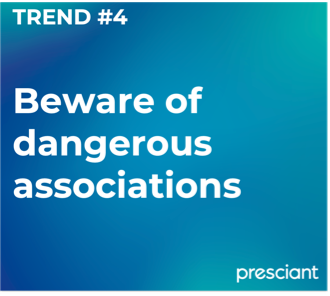
The mad fad for influencers is to blame. Brands are so anxious to jump on the influencer bandwagon, they don’t stop to think. They run after any old trending TikTok’er or celebrity and get into bed with the most unlikely brand partners.
The Yeezy brand became toxic following Kanye West’s antisemitic remarks and the White Lives Matter t-shirt he wore at Paris fashion week. Companies have rushed to sever their links with him, conscious that it was ruining their brands. Adidas ended its highly successful 7-year partnership, Balenciaga ended its Ye Engineered by Balenciaga drops, and Gap abandoned a 10-year deal. People are throwing Yeezy sneakers out of their closets and retail stores are rejecting them as well. Kanye West is no longer a billionaire, and the brands associated with him have not escaped big hits.
So ridiculous, it feels like a spoof, is Juicy Couture’s partnership with Kraft Mayo. The first item in the “Smooth Lovers” collection, a blue velvety tracksuit with rhinestone lettering, dropped in November. It’s being sold on the “Mayo Couture” website for $162. Mayonnaise-branded clothing?
Huge damage is being done by music artists’ brand associations with Ticketmaster. The artists are powerless since Ticketmaster’s acquisition of Live Nation gave it a virtual monopoly of concert sales. Any company an artist partners with is an extension of their fan’s experience with their brand. First Taylor Swift, then Bad Bunny have had the value of their brands imperiled when Ticketmaster messed up its ticket selling.
What can brands do to prevent this? Recognize that a brand partnership is a serious decision. Before partnering, make sure that the brand is a fit and your partners are trustworthy. Put stringent agreements in place. Monitor your partner’s actions and behaviors. And if things go wrong, apologize, and take action swiftly.
Don’t imitate Bad Bunny. Mexico’s President saw the turmoil as an insult and asked Bad Bunny to issue a full refund, come back to Mexico City and play for free. Bad Bunny turned him down.
Do follow the example of Taylor Swift, whose response is a master class in owning your brand. She immediately took accountability, expressed her own frustration with the situation.
Ticketmaster is now being investigated by the Justice Department.

According to Marc, “multicultural marketing is THE biggest growth opportunity because multicultural marketing IS mainstream marketing.” 100% of US population growth in the past 10 years came from increases in the Black, Hispanic, Asian, Pacific Islander, Native, Indigenous, multi-racial and multi-ethnic communities with buying power of $5 trillion plus. Historically, brands have not marketed to these communities, skewed market research against them, not featured them in ads, nor created communications that were relevant to them. Branded products have major share gaps versus unbranded products. P&G estimates that closing its brand share gaps among multicultural consumers would add $500+ million in sales annually.
How should brands do this? Break old habits.
Change the mindset from general to multicultural. Stop using the archaic term “general market” that results in marketing to the average.
Make multicultural marketing everyday marketing. This means specific and precise marketing to each consumer group.
Make research inclusive. Switch from “representative” samples skewed to White demographics, to inclusive research that delves into audiences of every kind—Black, Hispanic, Asian-Pacific, Native-Indigenous, People with Disabilities, LGBTQ+, and White.
Stop focusing on a national average media reach which limits brands to being “averagely insufficient” among each consumer group. Build plans that maximize reach to 80-90% of each multicultural consumer group.
Brands that do all this will grow their sales and share faster, not only within multicultural markets, but across the whole market.
By conducting research by consumer group, Always discovered that many women are using the wrong size pad. They made product, packaging and sizing changes, reconfigured store shelves, and changed their advertising to be more representative. The result: the brand is growing in all consumer groups and has above average market shares among Black, Hispanic, and Asian-Pacific consumers.
Vicks spotted that Hispanic consumers love sensorial experiences and prefer to medicate at home, designed programs and products for them and sponsored Hispanic teams and soccer leagues. Household penetration in this community has risen to 14 points above the national average.
And it’s not just P&G brands. Old Spice has transformed its appeal to Black men, featuring Deon Cole and Gabrielle Dennis in the ‘Men have skin too’ campaign and is now expanding to Asian-Pacific men. Olay is developing unique programs for Chinese Canadians.
The growth opportunity is huge. But it’s not easy. It requires a major mindset shift.
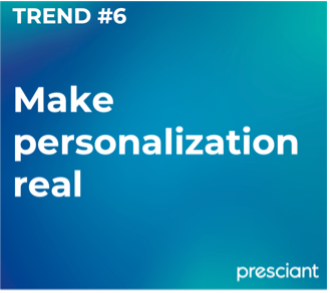
This is all the wrong way round. What personalization means is putting the customer at the center. It is thinking about the customer as a whole person, looking at them not through the lens of a particular products but understanding their full set of needs as they go through their day to day lives. The customer journey writ large. As Nick Graham of Mondelez puts it: It’s about “putting the person back into personalization.”
This idea has long been understood and acted on in the tech world, by Amazon, Google, and others. It is generally understood but not acted on by B2C marketers. Few retailers are able to track the same customer across their online and off-line channels. A recent Gartner study shows that globally only 14% of companies have a 360° view of their customer. The concept of personalization is starting to penetrate the B2B world, with the trend towards Account Based Marketing. This is the idea that marketing across product siloes will generate cross selling and upselling and multiply revenues. This is easy to say, but difficult for most companies to act on. IT systems, distribution channels and supply chains all work independently and have to be integrated. IBM was an early apostle, moving from selling software, systems, and services to holistic solutions (Smarter Cities, Smarter Healthcare and so forth). Most B2B companies have yet to follow.
Personalization in this sense is what all brands must start doing for success in 2023 and beyond. Start with the customer, not the product. It should be customer in, not product out. Follow this principle and you will revolutionize how you think about your future product roadmap and what innovation you pursue, how you organize your marketing, when and where you target customers and with what, which distribution channels you focus on and how you allocate your investment.
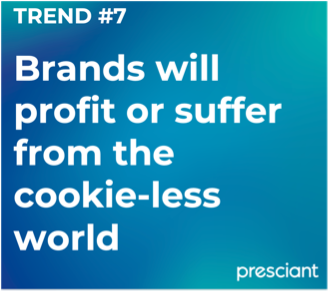
This sounds truly terrible, especially given the growing demand for personalization. There are predictions that the ROI from marketing investment will plummet. The marketing world largely has put its head in the sand hoping that someone else will solve this problem.
Presciant believes that the disappearance of cookies is nothing like as bad as it seems.
Why? First of all, the current targeting platforms are nothing like as accurate as people think. A recent study compared, gender, age range, and other basic demographics data from 16 leading digital targeting data service providers for a large sample of consumers. Shockingly, there was only 51% agreement on gender, and a pitiful 7% on ages. There is a great disparity in segmentation groupings generated by different suppliers utilizing basic demographics, let alone the more complex behavioral, lifestyle, life stage, and interest attributes. We are not losing as much as we think.
Brands that take action will be in a much better position than they are today. By cutting out the third-party middlemen and adopting more direct ways of interacting with their consumers can increase the accuracy of their targeting, enabling them to grow sales faster and attain much higher ROI. There are all sorts of different ways of doing this. Options include: getting data direct from your website; participating in ‘privacy sandboxes’ where consumers interested in a topic are labeled with group identifiers; creating totally anonymous ‘Universal IDs’; ‘contextual targeting’, where what ads are shown are based on the site the consumer is visiting; and ‘walled gardens’, closed ecosystems such as Google, Facebook and Amazon, where companies can collect and use data from users within the ecosystem, maintaining a high degree of certainty about the identity and behavior of users. The financial results of each approach urgently need to be quantified. Presciant is supporting an initiative from the Marketing Accountability Standards Board and Truthset to do exactly this.
If you sit around and wait, your ROIs are going to drop by 30-50%, due to the decrease in the precision of your targeting. Brands that move fast to identify and adopt new and better ways of doing it, have the opportunity get higher quality data, more dollars and jump ahead of their competitors.
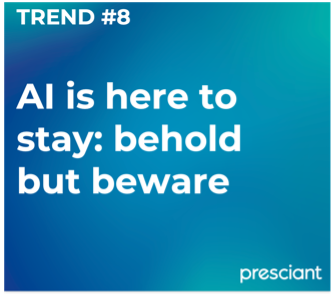
How to leverage AI in marketing? Let’s ask ChatGPT itself:
“AI has the potential to transform marketing in numerous ways. Here are some examples:
Personalization: AI can help marketers create personalized experiences for their customers by analyzing their behavior, preferences, and interests. This can lead to better customer engagement, loyalty, and conversion rates.
Predictive Analytics: AI can analyze vast amounts of data to identify patterns and predict future trends. Marketers can use this information to create targeted campaigns, optimize their marketing strategies, and forecast sales.
Chatbots: AI-powered chatbots can help businesses automate customer service and support, providing instant responses to customer inquiries and delivering a personalized experience.
Image and Video Recognition: AI can analyze images and videos to identify objects, people, and other elements, enabling marketers to create targeted campaigns based on visual content.
Content Creation: AI can generate content for marketing campaigns, such as product descriptions, social media posts, and ad copy. This can save marketers time and resources, and ensure consistency in messaging.
Customer Segmentation: AI can segment customers into groups based on their behavior and characteristics, allowing marketers to tailor their campaigns to specific audiences.
Overall, AI has the potential to improve marketing by enabling more targeted, personalized, and effective campaigns, while also reducing the time and resources required for marketing activities.”
So what is there to beware of? The big risk to brands is the loss of authenticity and uniqueness. Marketers need to keep control of defining and shaping their brand strategies. Do not hand over the creation of your brand purpose, visual and verbal identity to AI. Your brand is what creates a unique emotional attachment with your consumers, that inexplicable tug that draws them to you. Surfacing these insights might be a task for AI, but crafting them into a unique proposition is a human endeavor.
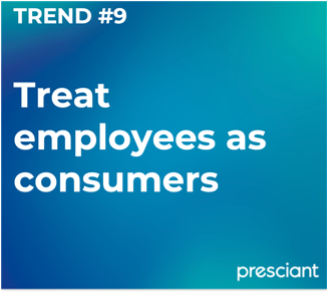
Focusing your brand on employees leads to lower costs, lower working capital needs and higher sales. Brand works on two levels:
Improves the customer experience: If your employees don’t love your brand and act in accordance with its purpose and values, no-one else will love it or prefer your products over competitors. This holds true for all employees, not just people who directly connect with customers. If they don’t live your brand, R&D won’t develop innovations which fit with it, IT and operations won’t implement systems and processes which deliver on your promise, manufacturing won’t put the right quality control in place, finance won’t set the right price and margin goals.
Improves employee recruitment, retention and performance. If your brand doesn’t appeal powerfully to the people you want to hire, you won’t be able to recruit them easily and you’ll have to pay them more. If your employees don’t feel a strong affinity to the brand, they’ll be less productive. They won’t throw themselves into their work, come up with new ideas, and will work for pay, not passion. They’ll be less satisfied, less likely to stay, less likely to recommend your company to others, and your recruiting costs will soar.
Brands that will succeed in 2023 will understand this, develop compelling employee value propositions and change their talent practices to match.
How do you do this? Follow 5 simple principles:
- Create an EVP which reflects your Purpose but is different from it. It should speak equally to the emotional fulfillment of employees from advancing the Purpose and the practical personal development they will get from working for you. Explain how this applies to all different job functions.
- Talk about the benefits employees will get from working at the company, not about how wonderful the company is and what it expects from employees.
- Make your employees the spokespeople and advocates for your talent brand. Have a clear recruiting target and feature employees who represent it.
- Set up your own talent YouTube channel. Effective employee communications today are all about YouTube. Other channels are secondary.
- Live up to your EVP’s promise in everything the company does. To communicate it, your employees must truly experience it and believe in it.
Learn from the most successful employer brands. Microsoft translates its Purpose, ‘Empower the world’, into a distinct but closely related EVP, ‘Create the future you want’. All Google talent communications are made by young employees from the diverse backgrounds similar to those they want to hire. A company-wide employee ambassador program was central to GE’s employer brand turnaround. Some brands have created their own employee language to foster community. IBM started this with the concept of ‘IBMers, Google has ‘Googlers’ and ‘Googleyness’, Honeywell has ‘FutureShapers’.
Some of the best EVPs come from tech, not surprisingly given the recent war for talent. But the leading tech brands (the world’s most valuable brands), have no plans to deviate from them, despite letting thousands go. The economic benefits of employee branding are too great. Companies that invest in employer brand engagement are 4x more profitable, outperform their peers by 147% in earnings per share, and revenues are 18% higher.
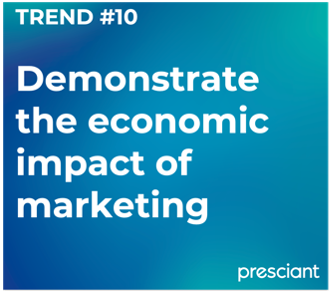
Today marketing’s importance as the driver of the demand chain is not recognized. People do not see that its job is to generate revenue and margin growth, customer insights and the direction for innovation. Marketing is not respected. 90% of CEOs trust their CFOs and astonishingly, their CIOs. 80% do not trust their marketers. This has caused the notoriously short tenure of CMOs, the proliferation of new titles, representing CEO dissatisfaction with the marketing function and struggle to find a partner in driving profitable growth.
As economic uncertainty accelerates, the CEO’s priority has shifted from growth to efficiency. This has put marketing in a bind. Its costs are very visible, its impact on profits is not. Marketers have been clutching at any straw that looks like it will demonstrate results. Efficiency of spend has been prioritized over effectiveness, short-term over long-term, promotions over brand.
The result is lack of traction, inability to leverage prior investment, resulting in suboptimal marketing impact. Short tenure only compounds the problem. There is no value placed on continuity. Changing CMOs means frequently changing tactics, further diminishing impact. The impact that marketing does have is not understood because marketers do not know how to communicate it. They do not speak the language of CEOs and CFOs. Non-financial metrics still predominate over those the firm has to report, like cash flow.
All these pressures force accountability to the top of marketers’ agendas. This came up strongly in a recent meeting of the ANA CMO Council. New research suggests the economic impact of marketing is displacing diversity as CMO’s #1 priority. The marketing profession is finally lifting its head and rising to the unmet but doable challenge of demonstrating its economic impact.
The solutions are there. Or at least the materials for them.
It’s not just about “performance marketing” and short-term tactics measured in clicks and leads. What is “performance marketing” anyway? We believe all marketing should perform.
It’s not just about marketing mix modeling which is seeing a resurgence. It tracks only short-term, whatever it claims. It looks backwards. Its predictions assume the environment will not change. These measures have their place.
But there are others which are more important. Two are critical.
One is measuring the financial value that brand can generate which is much larger than the value generated by purely short-term actions.
The other is big data which can be enormously useful to marketers if they know how to pluck out and apply the right metrics from the deluge and ensure their quality. A great deal of work on big data and AI is underway.
The pieces exist. They need pulling together into usable tools. We urge marketers to collaborate to demonstrate the economic impact and incredible importance of what we do.